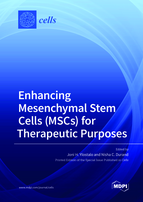Enhancing Mesenchymal Stem Cells (MSCs) for Therapeutic Purposes
A special issue of Cells (ISSN 2073-4409). This special issue belongs to the section "Stem Cells".
Deadline for manuscript submissions: closed (31 May 2022) | Viewed by 35207
Special Issue Editors
Interests: mesenchymal stem cell (MSC) biology; 3D-cell culture; microbiology; immunology; regenerative medicine
Special Issues, Collections and Topics in MDPI journals
Interests: mesenchymal stem cells (MSC); MSC potentiation; MSC scale-up; regenerative medicine; immunomodulation; MSC signaling; clinical and translational research; process development
Special Issues, Collections and Topics in MDPI journals
Special Issue Information
Dear Colleagues,
The regenerative and immunomodulatory properties of mesenchymal stem cells (MSCs) have made these cells the focus of multiple pre-clinical studies and clinical trials. While the results from these clinical studies have established that MSCs are safe, the efficacy of these cells is not as well-established. In this regard, there have been increased efforts towards generating potentiated/activated MSCs with enhanced therapeutic efficacy. Mechanisms for enhancing MSC potency and efficacy are an area of active research with great potential for translation into clinical settings.
This Special Issue solicits original research manuscripts and reviews from a broad range of topics relating to potentiation strategies for enhancing MSC therapeutic efficacy, which include but are not limited to hypoxic and growth factor pre-conditioning, serum starvation, genetic manipulation, and 3D culture.
Dr. Joni H. Ylostalo
Dr. Nisha C. Durand
Guest Editors
Manuscript Submission Information
Manuscripts should be submitted online at www.mdpi.com by registering and logging in to this website. Once you are registered, click here to go to the submission form. Manuscripts can be submitted until the deadline. All submissions that pass pre-check are peer-reviewed. Accepted papers will be published continuously in the journal (as soon as accepted) and will be listed together on the special issue website. Research articles, review articles as well as short communications are invited. For planned papers, a title and short abstract (about 100 words) can be sent to the Editorial Office for announcement on this website.
Submitted manuscripts should not have been published previously, nor be under consideration for publication elsewhere (except conference proceedings papers). All manuscripts are thoroughly refereed through a single-blind peer-review process. A guide for authors and other relevant information for submission of manuscripts is available on the Instructions for Authors page. Cells is an international peer-reviewed open access semimonthly journal published by MDPI.
Please visit the Instructions for Authors page before submitting a manuscript. The Article Processing Charge (APC) for publication in this open access journal is 2700 CHF (Swiss Francs). Submitted papers should be well formatted and use good English. Authors may use MDPI's English editing service prior to publication or during author revisions.
Keywords
- MSCs
- efficacy
- potentiation
- pre-conditioning
- genetic manipulation
- hypoxia
- translational research
- animal models
- 3D culture








